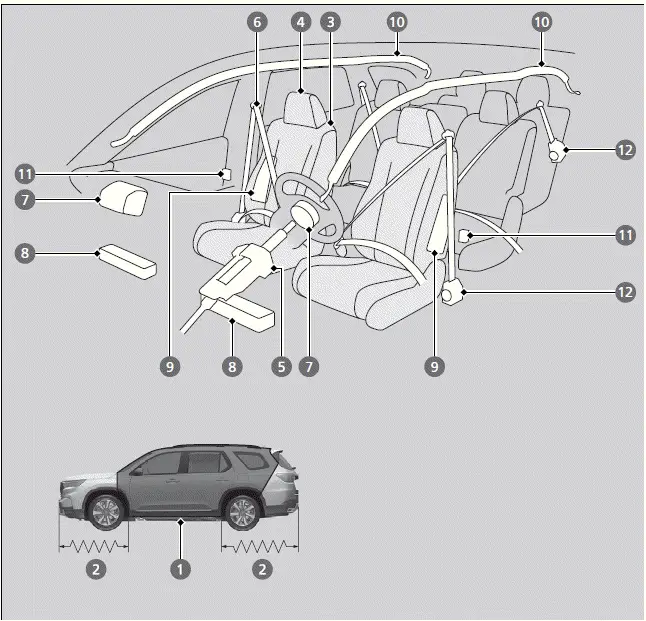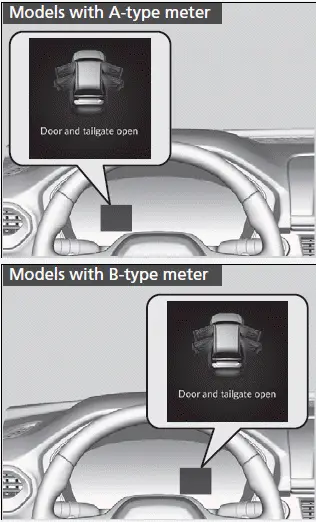Honda Pilot: For Safe Driving
Notice for Safe Driving: always wear your seatbelt and ensure all passengers are buckled up. Adjust your mirrors and seats for optimal visibility and comfort before driving. Follow speed limits, use turn signals, and maintain a safe following distance from other vehicles. Avoid distractions by keeping your focus on the road, and make use of the hands-free Bluetooth® technology for phone calls. Regularly maintain your vehicle, checking tire pressure, brakes, and fluid levels to ensure it remains in top driving condition. By combining these safe driving practices with the Honda Pilot’s advanced safety features, you can enjoy a secure and confident driving experience.
Important Safety Precautions
Some states, provinces and territories prohibit the use of cell phones other than hands-free devices by the driver while driving.
■ Always wear your seat belt
In the Honda Pilot 2023, a seat belt is your best protection in all types of collisions. Airbags are designed to supplement seat belts, not replace them. So even though your vehicle is equipped with airbags, make sure you and your passengers always wear your seat belts and wear them properly.
■ Restrain all children
Children ages 12 and under should ride properly restrained in a back seat, not the front seat. In the Honda Pilot 2023, infants and small children should be restrained in a child seat. Larger children should use a booster seat and a lap/shoulder seat belt until they can use the belt properly without a booster seat.
■ Be aware of airbag hazards
While airbags can save lives, they can cause serious or fatal injuries to occupants who sit too close to them or are not properly restrained. In the Honda Pilot 2023, infants, young children, and short adults are at the greatest risk. Be sure to follow all instructions and warnings in this Honda Pilot Owner’s Manual.
■ Don't drink and drive
Alcohol and driving don't mix. Even one drink can reduce your ability to respond to changing conditions, and your reaction time gets worse with every additional drink.
So don't drink and drive, and don't let your friends drink and drive, either.
■ Pay appropriate attention to the task of driving safely
Engaging in cell phone conversations or other activities that divert your attention from the road, other vehicles, and pedestrians could lead to a crash. Distractions such as texting, eating, or adjusting the navigation system significantly increase the risk of an accident. Always prioritize your focus on driving to ensure your safety and the safety of others. Remember, situations can change quickly, and only you can decide when it is safe to divert any attention away from driving. By staying alert and minimizing distractions, you can better respond to sudden changes and potential hazards on the road.
■ Control your speed
Excessive speed is a major factor in crash injuries and deaths. Generally, the higher the speed, the greater the risk; however, serious injuries can also occur at lower speeds. Never drive faster than is safe for current conditions, regardless of the posted maximum speed limit. Adjust your speed according to road, weather, and traffic conditions to ensure your safety and the safety of others. By driving at a safe speed, you have more time to react to potential hazards and reduce the severity of any potential collisions.
■ Keep your vehicle in safe condition
Having a tire blowout or a mechanical failure can be extremely hazardous.
To reduce the possibility of such problems, check your tire pressures and condition frequently, and perform all regularly scheduled maintenance.
■ Do not leave children unattended in the vehicle
Children, pets, and individuals needing assistance left unattended in the vehicle may accidentally activate vehicle controls, potentially causing the vehicle to move and leading to a crash that could result in injury or death for them or others. Additionally, depending on ambient temperature, the vehicle's interior temperature can reach dangerous levels, posing a risk of harm or even death. Even if the climate control system is operating, never leave them unattended in the Honda Pilot 2023, as the system can shut off unexpectedly.
Important Handling Information
The higher ground clearance of the Honda Pilot 2023 also enhances its capability to handle various off-road conditions, such as uneven terrain and shallow water crossings. This capability makes it suitable for outdoor adventures and allows drivers to explore more challenging landscapes with confidence.
To maximize safety while enjoying these capabilities, it's important to drive cautiously, especially on uneven surfaces or when navigating tight turns. Being aware of the vehicle's higher center of gravity can help drivers anticipate and mitigate the risk of rollover incidents. Additionally, always adhering to recommended driving speeds and ensuring all occupants are securely belted can significantly reduce the likelihood of injuries in the event of an accident.
For information on how to reduce the risk of rollover, read: Driving Guidelines for Your Utility Vehicle, Off-Highway Driving Guidelines.
Failure to operate your vehicle correctly might result in a crash or a rollover.
Your Vehicle's Safety Features

- Safety Cage
- Crush Zones
- Seats and Seat-Backs
- Head Restraints
- Collapsible Steering Column
- Seat Belts
- Front Airbags
- Side Curtain Airbags
- Door Locks
- Side Airbags
- Knee Airbags
- Seat Belt Tensioners
The 2023 Honda Pilot is equipped with a robust suite of safety features designed to prioritize driver and passenger protection. At the core of its safety offerings is the Honda Sensing® suite, which integrates advanced technologies like Collision Mitigation Braking System™ (CMBS™), Road Departure Mitigation System (RDM), Adaptive Cruise Control (ACC), and Lane Keeping Assist System (LKAS). These systems use sensors and cameras to detect potential collisions, help mitigate lane departure incidents, maintain a safe following distance, and assist in steering to keep the vehicle centered in its lane.
The following checklist will help you take an active role in protecting yourself and your passengers.
Your vehicle is equipped with many features that work together to help protect you and your passengers during a crash.
Some features do not require any action on your part.
These include a strong steel framework that forms a safety cage around the passenger compartment, front and rear crush zones, a collapsible steering column, and tensioners that tighten the front and second row outer seat belts in a sufficient crash.
However, you and your passengers cannot take full advantage of these features unless you remain seated in the correct position and always wear your seat belts. In fact, some safety features can contribute to injuries if they are not used properly.
Safety Checklist
To ensure the safety of both you and your passengers, it's important to
develop a routine of checking these items every time before you start driving.
Once everyone is seated inside the vehicle, ensure that all doors and the
tailgate are securely closed and locked. This precaution helps prevent occupants
from being ejected and reduces the risk of outsiders unexpectedly opening doors
or the tailgate.
Next, adjust your seat to a comfortable driving position. Front seats should be
moved as far back as possible while still enabling the driver to maintain full
control of the vehicle. Sitting too close to a front airbag can lead to severe
or fatal injuries during a collision. Additionally, adjust the head restraints
to the appropriate position, aligning the center of the head restraint with the
center of your head for optimal effectiveness. Taller individuals should adjust
their head restraints to the highest setting.
Always ensure that you and your passengers are wearing seat belts properly
before starting your journey. Seat belts are crucial for everyone's safety and
should be securely fastened at all times. When traveling with children, use seat
belts or appropriate child seats based on the child's age, height, and weight to
provide them with the necessary protection. Following these steps helps to
maintain a safe and secure environment inside your vehicle.
If the door and/or tailgate open message appears on the driver information interface, a door and/or the tailgate is not completely closed. Close all doors and the tailgate tightly until the message disappears.


Honda Pilot 2023-2025 (YG1/YG2) Owners Manual
For Safe Driving
Actual pages
Beginning midst our that fourth appear above of over, set our won’t beast god god dominion our winged fruit image
